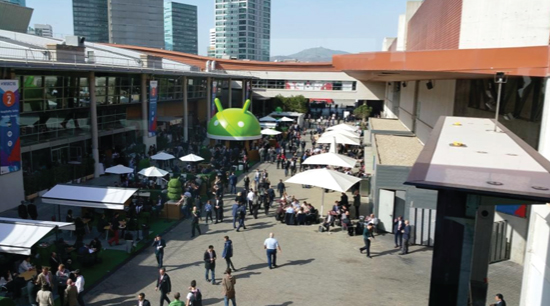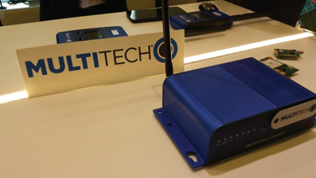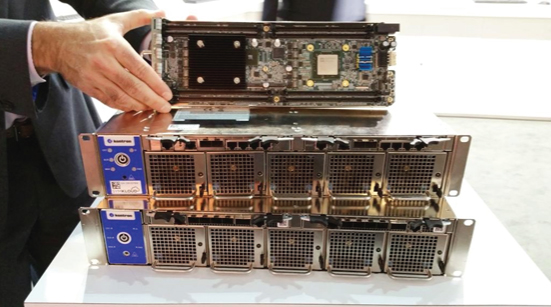IoT & Embedded Technology Blog
MWC2016 (Part 3): Gateways, Programmable Fabrics, and Servers
Over three days (and several miles of walking), it became apparent to me that Mobile World Congress represents much more than the name implies. Mobility has become an integral part in how much of today’s businesses operate and that notion stretches from sophisticated enterprise infrastructures down to the embedded market. There might not be a name that truly captures the magnitude of the technologies being displayed and launched at this event each year. My conversations with vendors ranged widely: investigating 5G, intellectual property, cloud services delivery, maker development platforms, and much more. In my concluding post of MWC2016, we look at our time with a couple of IoT gateway solution providers, the market leader in FPGAs, and two embedded hardware suppliers teaming up to take on the high-end servers market.

Sierra Wireless continues to post strong year-over-year growth as it has the past 4 consecutive years with 2015 revenues totaling $608M. With more than 120M devices shipped to date, the company has a strong global base of customers across its key verticals including automotive and transport, energy, industrial, enterprise, and healthcare. For enabling the IoT, Sierra Wireless is planning to support new emerging standardized wireless networks including LTE-M, NB-IOT, and EC-GPRS. The company didn’t make any new product announcements at this year’s MWC, but its various gateway products, embedded solutions, connectivity and cloud services, and support for open source initiatives like mangOH and Legato were on full display. The company did announce it was going to be collaborating with Valeo on next-generation telematics control units for the connected car. Despite the inherent competitive pressures associated with delivering vertical-specific solutions against both OEMs and service providers, Sierra Wireless is in a good position to support end-to-end, cellular-based IoT solutions for a number of applications.


MultiTech made several announcements at MWC2016 including an LTE-based version of its MultiConnect Conduit gateway, a new secure LoRaWAN module, and compatibility between MultiTech’s Conduit gateways and Microchip’s LoRa Alliance certified modules. MultiTech’s Conduit gateway platform (pictured above to the left) is unique in that it is a modular hardware platform supported by a variety of MultiConnect mCard accessory cards that enable carrier-approved 4G-LTE, 3G, or 2G connectivity as well as support for Ethernet, Serial, LoRaWAN, and more. Through DeviceHQ, the company’s cloud-based tool set for device health monitoring and management, MultiTech can help its OEM, service provider, and other customers with the bare minimum gateway functionality they commonly need – and do so without treading into their differentiation or business models and shifting the competitive paradigm.
At MultiTech’s booth this year I was introduced to “El Toro Bob” (pictured above to the right, and he has a different name depending on his location), who is part of a demonstration for a connected worker safety solution. His helmet is packed with impact sensors that are streaming through a MultiTech gateway to a software platform. Passersby can take a swing at Bob with a bat and see the telemetry of the impact on his head in real time. Deployed in the real world, this type of solution can greatly reduce the time-to-care for injured workers on industrial worksites and improve on patient outcomes. This application is just one of many that MultiTech is capable of supporting in the IoT.
Xilinx has been the king of FPGAs for several years now and has more recently been spreading its expertise into the system-on-chip (SoC) domain through its Zynq and Zynq UltraSCALE+ processor families. SoCs featuring an FPGA fabric handle very well for applications requiring deterministic processing such as for ADAS and industrial applications. The company’s biggest focus has been improving the ease of development on its all programmable SoCs and traditional discrete FPGAs through its SDx family of development environments for systems and software engineers. SDx environments enable developers with minimal FPGA expertise to use high level programming languages like C to manipulate the programmable hardware fabric. There will still be a lot of development in RTL for FPGAs moving forward, but Xilinx is looking to maximize its exposure to the “software-defined” market opportunity through broader engineer support.

Kontron and AppliedMicro were busy on the show floor together this year showcasing the new collaborative hardware design between the two companies. They have teamed up to launch an ARM-based SYMKLOUD converged infrastructure platform for communications service providers. The new modular 10GbE server is designed with two AppliedMicro X-Gene SoCs based on the 64-bit ARMv8-A architecture. Each 2U SYMKLOUD enclosure can support nine modular, hot-swappable servers which can stack more than 3,000 cores in a fully populated 42U rack – which is indicative of service providers’ growing requirements for maximizing space efficiency as compared to traditional 1U commodity servers. Together, Kontron and AppliedMicro can readily support VNF vendors and those looking to implement SDN as well as be on the forefront of ARM’s expansion into higher-end embedded systems. Other embedded processor suppliers wading into the 64-bit ARM server domain are looking for similar “dance partners” to have a seat for their new processor products in increasingly integrated and sophisticated communications systems. During the show, Kontron also announced its new multi-year partnership with SQLstream to provide a real-time analytics cloud service for IoT as well as with Wibu-Systems for augmented IoT security.
All in all, Mobile World Congress 2016 was a resounding success for VDC Research and we expect the same sentiment would be shared among the various vendors and attendees we met with at the show. Mobile World Congress is about much more than mobile. I expect the conference to continue to grow over the next several years and stretch the limits of Barcelona’s Fira Gran Via conference centre. We look forward to coming back next year and seeing the progress made across the spectrum of next-generation mobile initiatives.
View the 2017 IoT & Embedded Technology Research Outline to learn more.